Humanitarian Mapping as a Contribution to Achieving Sustainable Development Goals: Research into the Motivation of Volunteers and the Ideal Setting of Mapathons
Abstract
:1. Introduction
- Goal 1—No Poverty—Putting villages and household footprints on a map is often the first step in giving communities a voice in land rights. Geospatial information is critical in helping people claim their property rights. Kenya’s Map Kibera project (begun in 2009) collects citizen-generated data and other kinds of relevant open data in one of the region’s biggest slums-turned-informal-cities to enhance citizen accountability, development planning, and government use.
- Goal 3—Good Health and Wellbeing—Public health data collection projects provide local governments and organizations with information to improve their response to health-related issues, such as malaria prevention. In 2018, the HOT supported malaria elimination projects on the ground in Guatemala and Botswana by providing geographical data and training. Data were used for logistics and indoor residual spraying campaigns, for bed net distribution, and for improved monitoring and evaluation to measure intervention impacts.
- Goal 4—Quality Education—Crowdsourced mapping provides a two-fold benefit towards reaching the SDG for education: assisting partners, governments, and local communities in recognizing gaps in services and the distribution of educational facilities, as well as providing an opportunity for individuals in these groups to gain technical and vocational skills such as GIS and surveying.
- Goal 5—Gender Equality—Since 2015, the Crowd2Map project has been mapping rural Tanzania. These maps are used by community activists to locate and protect girls at risk of female genital mutilation, as well as to provide local officials with data needed to plan for the development of services.
- Goal 7—Affordable and Clean Energy—HOT completed the large-scale digitization of rural Tanzania using mapping and household surveys, identifying millions of buildings and more than a thousand villages. By collecting this highly detailed data on settlements, HOT enabled the government and private electricity and renewable energy providers to predict demand and determine where grid and off-grid connections can be made.
- Goal 9—Industry, Innovation, and Infrastructure—With OSM, roads and buildings can be mapped remotely while teams on the ground add important information such as building conditions and road surface quality.
- Goal 16—Peace, Justice, and Strong Institutions—Crowdsourced mapping promotes participatory action that increases the representation of communities. OSM is used by humanitarian agencies in decision-making.
- OSM project Community Mapping for Exposure, Indonesia (2011)—the project worked with local governments, university students, and civil society groups. The mapping work focused primarily on critical infrastructure in the capital region of Jakarta, including schools, hospitals, community centers, and places of worship. The resulting data were combined with hazard information from a variety of sources to produce realistic impact scenarios [19].
- Open Cities project Batticaloa (2012)—Batticaloa, a major city in Sri Lanka’s Eastern Province severely affected by the 2004 Indian Ocean tsunami, is located in a hazard-prone area that has suffered near-annual droughts, floods, and cyclones. Footprints and basic building characteristics, including the number of floors, usage, and the construction materials used for walls and roofs were collected for all buildings in the area [19].
- Open Cities Kathmandu (2012)—Kathmandu, the capital city of Nepal, is the most seismically at-risk city in the world in terms of the potential for loss of human life during a major event. Open Cities Kathmandu surveyed 2256 schools and 350 health facilities in the Kathmandu Valley [19].
- One Map Myanmar (2018)—The American Red Cross has been working alongside the Myanmar Red Cross to better understand the locations of critical infrastructure and roads in order to allow decision-making during major disasters such as floods and cyclones [20].
- Burundi anti-malaria campaign (2020)—Médecins Sans Frontières/Doctors Without Borders (MSF) has prevented the disease from spreading in eastern Burundi with an indoor residual spraying campaign. As large parts of the area were not mapped, Missing Maps volunteers traced nearly 90,000 buildings in the rural region of Ruyigi in Burundi. Over the following month, teams on the ground managed to spray 97% of these households [21].
1.1. Citizen Science as an Umbrella for Humanitarian Mapping
1.2. The Humanitarian OpenStreetMap Team and the Missing Maps Project
1.3. (Dis)Connections and Engagements between Stakeholders Related to Humanitarian Mapping
- their contribution to OSM is low; we speak of ‘hit-and-run’ contributors [60],
- the average number of mistakes in mappings performed by new participants in humanitarian mapping activities is higher than the average number produced by other more experienced participants [56],
- most new participants do not become regular participants [61].
- Humanitarian mappings should be organized with as many local contributors as is feasible. Such a step is crucial for synergy between both stakeholder groups [63]. The participation of local contributors from the mapped countries adds value to the remote action, as described by Solís et al. [16,18] regarding the case study of Kathmandu Living Labs. It allows for the creation of both local and remote open data.
- The number of repeat participants should be increased. This is also one of the primary goals of the efforts described in our paper. Increasing the number of repeat participants would lead to an improvement in the overall quality of mapping thanks to (1) the further training received by less-experienced mappers and (2) the greater input received from highly experienced contributors [62].
- Unlike classical contributions to OSM, humanitarian mapping allows for the secondary revision of created data by more experienced users, regarded as “validators” [16]. The shorter initial training of humanitarian mappers should be compensated by the more complex training of validators and organizers of mapathons [64] as well as the development of data validation tools, even during the mapping process [61]. The role of humanitarian mapping validators is essential for maintaining the high quality of all contributions made during humanitarian mapping—in particular, at mapathons.
1.4. Looking for the Motivations of VGI Contributors
1.5. Experiences with Mapathons—How to Make Them Successful
- Mapathons should include a mix of less and more experienced participants so that attendees who are experienced in mapping can provide necessary peer support.
- Refreshments should be served in a separate area—food served in a separate room may disrupt work, but it also encourages communication between participants.
- Technical issues at mapathons (especially a weak internet connection or too few electrical outlets) should be kept to a minimum, as they diminish the participants’ overall experience.
- Some universities give additional credit to students who participate in mapathons [24,28]. Students use it to improve their grades, so this gesture boosts attendance. On the other hand, some studies cast doubt on this approach. Clary and Snyder found that there was a slightly negative relationship between prior experience and future intentions to volunteer for students who felt under external pressure to volunteer [71].
- Students participating in Youth Mappers are involved voluntarily and regularly organize mapathons for their members [24].
- Sometimes, finding a date for a mapathon suitable for most students is challenging (e.g., during exam periods). A humanitarian mapping project could be selected on the HOT Tasking Manager, which would allow contributors to contribute for a whole week [24].
- A mapathon could include a Skype call with a practitioner from the agency requesting the data in order to provide context [24].
- Find a space that fits your group—a library, community center, university, private company, etc.
- Publicize your event on social media, on websites, in the local OSM community, etc.
- A strong Internet connection (typically wifi) is necessary. Slow wifi is the worst threat to the success of a mapathon.
- Recruit organizers/helpers. One helper is recommended for every 10 mappers at in-person events and for every 2 or 3 mappers online, depending on the group size.
- There must be a sufficient number of extension cords for everyone to power a laptop.
- Extra laptops/computers for people that may not bring their own are a good idea.
- Print training and publicity materials—available on MissingMaps.org.
- Arrange refreshments for the mappers. They will stay longer, and they will map longer. “Pizza fills the Map!”
- Invite a special guest who can present his experience from the field (e.g., MSF, HOT, OSM, etc.).
- Inform people about the mapping task and the locality; speak with them about what they see on the map.
- Use a group hashtag during mapping. It allows the results of your group to be summarized after more mapathons or at the end of the year.
- Show the mapathon results—the number of mapped buildings and paths; use a leaderboard to show the best mapper of the mapathon.
- At the end of the mapathon, go to the pub with the mappers. It is a way of recruiting new organizers to your team.
- Search for and try new locations for mapathons. Try to reach companies.
- Allow participants to choose from more groups with different levels of experience—e.g., beginners, advanced mappers, experts/validators. Each group can have its own experienced trainer who explains tips appropriate to the level of his group.
- There should also be a group for participants who want to map without training and without being disturbed. Usually, this is the case with experienced mappers.
2. Materials and Methods
- Questionnaire answers about the motivations of contributors from the Czech and Slovak Missing Maps community for humanitarian mapping.
- Attendance statistics concerning the previous 18 mapathons organized in Brno city.
- location,
- day of the week,
- month of the year,
- the possibility to come without a laptop and use a borrowed computer.
3. Results
3.1. The Motivation for Contributing to Humanitarian Mapping
3.1.1. The General Motivation for Contributing without Division into Groups
- to produce beneficial results (“I believe that my work yields significant results”),
- to feel a sense of solidarity with other people (“helping other people is important for me”),
- to achieve personal satisfaction (“I like making maps”).
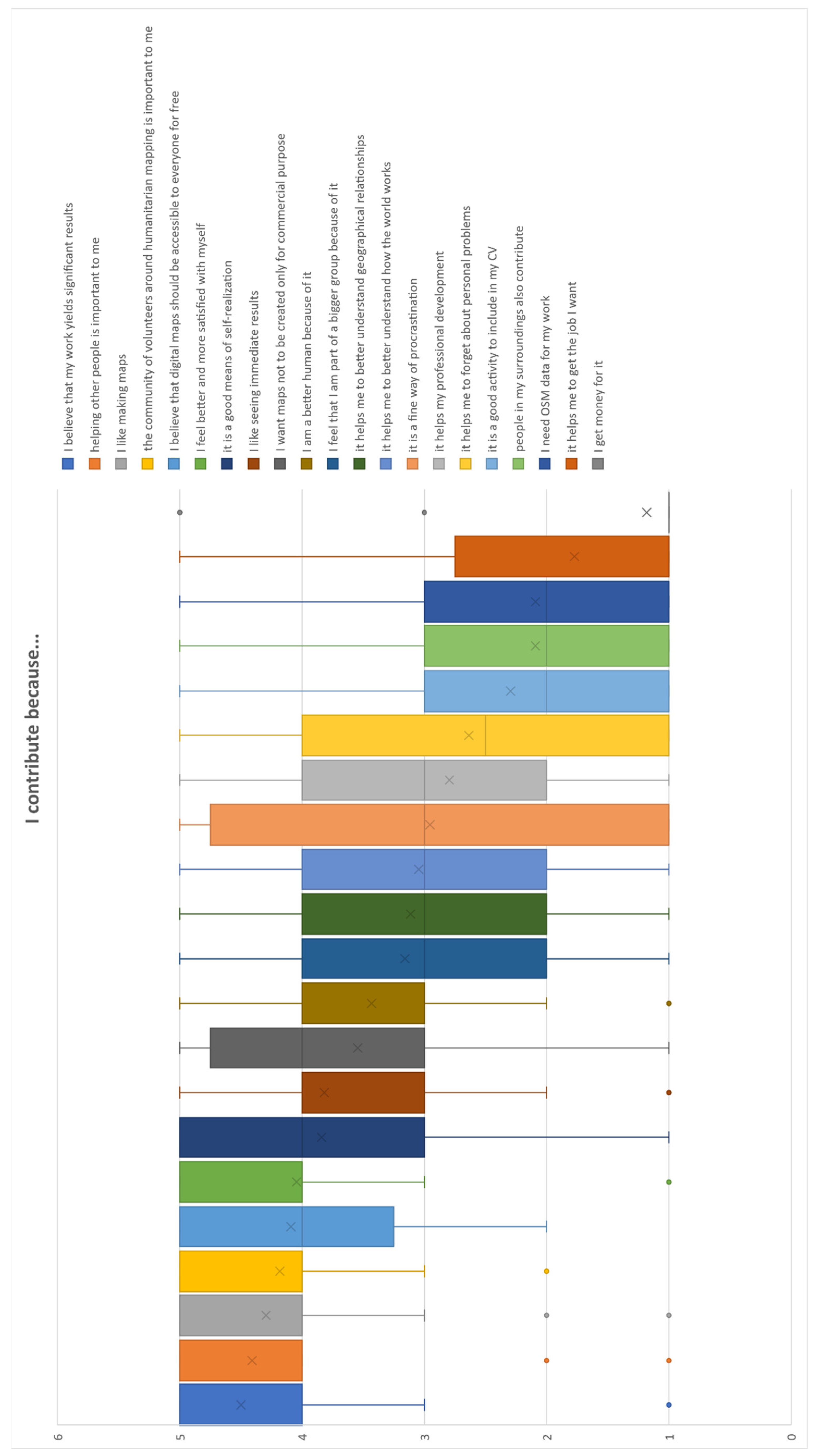
3.1.2. Differences in Motivation between Various Groups of Participants
3.1.3. Reasons for Former Contributors to Have Ceased Participation
- “I have a small child (already the third). I have not contributed since its birth. When I have time, I want to continue.”
- “Lack of time, but I would like to continue again.”
- “I rapidly reduced my mapping activities due to a higher workload.”
- “I moved outside Prague. I cannot go to mapathons.”
- “I live outside Prague. Maybe I will continue.”
3.2. Characteristics of Mapathons and Recurring Participants
3.3. Self-Assessment of Humanitarian Mappers
4. Discussion
4.1. The Motivation for Contributing to Humanitarian Mapping
4.2. Characteristics of Mapathons and Recurring Participants
4.3. Self-Assessment of Humanitarian Mappers
5. Conclusions and Future Plans
Author Contributions
Funding
Institutional Review Board Statement
Informed Consent Statement
Data Availability Statement
Acknowledgments
Conflicts of Interest
References
- The 17 Goals. Available online: https://sdgs.un.org/goals (accessed on 2 August 2021).
- Transforming Our World: The 2030 Agenda for Sustainable Development. Available online: https://sdgs.un.org/2030agenda (accessed on 2 August 2021).
- OpenStreetMap. Available online: https://www.openstreetmap.org/ (accessed on 1 May 2021).
- Viana, C.M.; Encalada, L.; Rocha, J. The Value of OpenStreetMap Historical Contributions as a Source of Sampling Data for Multi-Temporal Land Use/Cover Maps. ISPRS Int. J. Geo-Inf. 2019, 8, 116. [Google Scholar] [CrossRef] [Green Version]
- Jonietz, D.; Zipf, A. Defining Fitness-for-Use for Crowdsourced Points of Interest (POI). ISPRS Int. J. Geo-Inf. 2016, 5, 149. [Google Scholar] [CrossRef] [Green Version]
- Muttaqien, B.I.; Ostermann, F.O.; Lemmens, R.L.G. Modeling aggregated expertise of user contributions to assess the credibility of OpenStreetMap features. Trans. GIS 2018, 22, 823–841. [Google Scholar] [CrossRef]
- Yang, S.; Shen, J.; Konečný, M.; Wang, Y.; Štampach, R. Study on the Spatial Heterogeneity of the POI Quality in OpenStreetMap. In Proceedings of the 7th International Conference on Cartography and GIS, Sozopol, Bulgaria, 18–23 June 2018; Bandrova, T., Konečný, M., Eds.; Bulgarian Cartographic Association: Sofia, Bulgaria, 2018. [Google Scholar]
- Touya, G.; Antoniou, V.; Olteanu-Raimond, A.-M.; Van Damme, M.-D. Assessing Crowdsourced POI Quality: Combining Methods Based on Reference Data, History, and Spatial Relations. ISPRS Int. J. Geo-Inf. 2017, 6, 80. [Google Scholar] [CrossRef]
- Kankanamge, N.; Yigitcanlar, R.; Goonetilleke, A.; Kamruzzaman, M. Can volunteer crowdsourcing reduce disaster risk? A systematic review of the literature. Int. J. Disaster Risk Reduct. 2019, 35, 101097. [Google Scholar] [CrossRef]
- Konečný, M.; Reinhardt, W. Early warning and disaster management: The importance of geographic information (Part B). Int. J. Digit. Earth 2010, 3, 313–315. [Google Scholar] [CrossRef]
- Goodchild, M. Citizens as sensors: The world of volunteered geography. GeoJournal 2007, 69, 211–221. [Google Scholar] [CrossRef] [Green Version]
- Humanitarian OpenStreetMap Team. Available online: https://www.hotosm.org/ (accessed on 10 January 2021).
- What We Do. Available online: https://www.hotosm.org/what-we-do (accessed on 2 August 2021).
- A Practical Guide to Launching and Growing Open Mapping Initiatives at the National and Local Levels. Available online: https://documents1.worldbank.org/curated/en/967511563521548873/pdf/Open-Mapping-for-the-SDGs-A-Practical-Guide-to-Launching-and-Growing-Open-Mapping-Initiatives-at-the-National-and-Local-Levels.pdf (accessed on 2 August 2021).
- Open Mapping for the SDGs. Available online: https://sdgs.hotosm.org/ (accessed on 30 October 2021).
- Solís, P.; McCusker, B.; Menkiti, N.; Cowan, N.; Blevins, C. Engaging global youth in participatory spatial data creation for the UN sustainable development goals: The case of open mapping for malaria prevention. Appl. Geogr. 2018, 98, 143–155. [Google Scholar] [CrossRef]
- YouthMappers. Available online: https://www.youthmappers.org/ (accessed on 10 January 2021).
- Solís, P.; Rajagopalan, S.; Villa, L.; Mohiuddin, M.B.; Boateng, E.; Wavamunno, N.S.; Valencia, M.F.P. Digital humanitarians for the Sustainable Development Goals: YouthMappers as a hybrid movement. J. Geogr. High. Educ. 2020. [Google Scholar] [CrossRef]
- Forni, M.; Haack, J.; Soden, R.; York, D.; Sommerville, R.; Deparday, V. Open Data for Resilience Initiative: Planning and Open Cities Mapping Project, World Bank, Global Facility for Disaster Reduction and Recovery; World Bank: Washington, DC, USA, 2014; 96p. [Google Scholar]
- One Map Myanmar and Phandeeyar. Available online: https://www.missingmaps.org/blog/2018/09/24/mapping-in-myanmar/ (accessed on 15 November 2021).
- Burundi Anti-Malaria Campaign: Covering the Gap—A Year of Blogs—January 2020. Available online: https://www.missingmaps.org/blog/2020/01/29/a-year-of-blogs/ (accessed on 15 November 2021).
- Missing Maps—Putting the World’s Vulnerable People on the Map. Available online: https://www.missingmaps.org/ (accessed on 10 January 2021).
- Hosting a Mapathon. Available online: https://www.missingmaps.org/host/#Materials (accessed on 5 April 2021).
- Coetzee, S.; Minghini, M.; Solis, P.; Rautenbach, V.; Green, C. Towards understanding the impact of mapathons—Reflecting on YouthMappers experiences. Int. Arch. Photogramm. Remote Sens. Spatial Inf. Sci. 2018, XLII-4/W8, 35–42. [Google Scholar] [CrossRef] [Green Version]
- Hristova, D.; Quattrone, G.; Mashhadi, A.; Capra, L. The Life of the Party: Impact of Social Mapping in OpenStreetMap; ICWSM: Atlanta, GA, USA, 2013; pp. 234–243. [Google Scholar]
- Dittus, M.; Quattrone, G.; Capra, L. Social Contribution Settings and Newcomer Retention in Humanitarian Crowd Mapping. In Proceedings of the 8th International Conference, SocInfo 2016, Bellevue, WA, USA, 11–14 November 2016; Spiro, E., Ahn, Y.-Y., Eds.; Springer: Cham, Switzerland, 2016; Part II; pp. 179–193. [Google Scholar] [CrossRef] [Green Version]
- How to Host a Mapathon. Available online: https://www.missingmaps.org/assets/downloads/mapathon-materials/english/How_to_Host_a_Mapathon_EN.pdf (accessed on 6 April 2021).
- Green, C.; Rautenbach, V.; Coetzee, S. Evaluating student motivation and productivity during mapathons. Int. Arch. Photogramm. Remote. Sens. Spat. Inf. Sci. 2019, XLII-4/W14, 85–91. [Google Scholar] [CrossRef] [Green Version]
- Trojan, J.; Schade, S.; Lemmens, R.; Frantál, B. Citizen science as a new approach in Geography and beyond: Review and reflections. Morav. Geogr. Rep. 2019, 27, 254–264. [Google Scholar] [CrossRef] [Green Version]
- Kerski, J.J. Geo-awareness, geo-enablement, geotechnologies, citizen science, and storytelling: Geography on the world stage. Geogr. Compass 2015, 9, 14–26. [Google Scholar] [CrossRef]
- Turner, A. Introduction to Neo-Geography; O’Reilly Media, Inc.: Sebastopol, CA, USA, 2006. [Google Scholar]
- Wilson, M.W.; Graham, M. Situating Neogeography. Environ. Plan. A Econ. Space 2013, 45, 3–9. [Google Scholar] [CrossRef]
- West, S.E.; Büker, P.; Ashmore, M.; Njoroge, G.; Welden, N.; Muhoza, C.; Osano, P.; Makau, J.; Njoroge, P.; Apondo, W. Particulate matter pollution in an informal settlement in Nairobi: Using citizen science to make the invisible visible. Appl. Geogr. 2020, 114, 102133. [Google Scholar] [CrossRef]
- Alender, B. Understanding volunteer motivations to participate in citizen science projects: A deeper look at water quality monitoring. J. Sci. Commun. 2016, 15, A04. [Google Scholar] [CrossRef] [Green Version]
- Bonney, R.; Cooper, C.B.; Dickinson, J.; Kelling, S.; Phillips, T.; Rosenberg, K.V.; Shirk, J. Citizen science: A developing tool for expanding science knowledge and scientific literacy. BioScience 2009, 59, 977–984. [Google Scholar] [CrossRef]
- Dickinson, J.L.; Shirk, J.; Bonter, D.; Bonney, R.; Crain, R.L.; Martin, J.; Phillips, T.; Purcell, K. The current state of citizen science as a tool for ecological research and public engagement. Front. Ecol. Environ. 2012, 10, 291–297. [Google Scholar] [CrossRef] [Green Version]
- Zhang, G. Spatial and Temporal Patterns in Volunteer Data Contribution Activities: A Case Study of eBird. ISPRS Int. J. Geo-Inf. 2020, 9, 597. [Google Scholar] [CrossRef]
- Franzen, M.; Kloetzer, L.; Ponti, M.; Trojan, J.; Vicens, J. Machine Learning in Citizen Science: Promises and Implications. In The Science of Citizen Science, 1st ed.; Vohland, K., Land-Zandstra, A., Ceccaroni, L., Lemmens, R., Perelló, J., Ponti, M., Samson, R., Wagenknecht, K., Eds.; Springer: Cham, Switzerland, 2021. [Google Scholar] [CrossRef]
- Battisti, C.; Cerfolli, F. From Citizen Science to Citizen Management: Suggestions for a pervasive fine-grained and operational approach to biodiversity conservation. Isr. J. Ecol. Evol. 2021; in press. [Google Scholar] [CrossRef]
- Battisti, C.; Poeta, G.; Romiti, F.; Picciolo, L. Small Environmental Actions Need of Problem-Solving Approach: Applying Project Management Tools to Beach Litter Clean-Ups. Environments 2020, 7, 87. [Google Scholar] [CrossRef]
- Taft-Morales, M.; Margesson, R. Haiti earthquake: Crisis and response. Curr. Politics Econ. South Cent. Am. 2011, 4, 1–67. [Google Scholar]
- Reznik, T.; Horakova, B.; Szturc, R. Geographic Information for Command and Control Systems Demonstration of Emergency Support System. In Intelligent Systems for Crisis Management: Geo-Information for Disaster Management (GI4DM) 2012, 1st ed.; Zlatanova, S., Peters, R., Dilo, A., Scholten, H., Eds.; Springer: Berlin, Germany, 2013; pp. 263–275. [Google Scholar]
- Reznik, T.; Horakova, B.; Szturc, R. Advanced methods of cell phone localization for crisis and emergency management applications. Int. J. Digit. Earth 2015, 8, 259–272. [Google Scholar] [CrossRef]
- Arsanjani, J.; Bakillah, M. Understanding the potential relationship between the socio-economic variables and contributions to OpenStreetMap. Int. J. Digit. Earth 2015, 8, 861–876. [Google Scholar] [CrossRef]
- Sui, D.Z.; Goodchild, M.F.; Elwood, S. Volunteered Geographic Information, the Exaflood, and the Growing Digital Divide. In Crowdsourcing Geographic Knowledge: Volunteered Geographic Information (VGI) in Theory and Practice; Sui, D.Z., Elwood, S., Goodchild, M.F., Eds.; Springer: Dordrecht, The Netherlands, 2013; pp. 1–12. [Google Scholar] [CrossRef]
- Bandrova, T.L.; Konečný, M.; Yotova, A. Cartography development and challenges on the basis of Big Data. In Proceedings of the 5th International Conference on Cartography and GIS, Riviera, Bulgaria, 15–20 June 2014; Bandrova, T., Konečný, M., Eds.; Bulgarian Cartographic Association: Sofia, Bulgaria, 2014; pp. 164–173. [Google Scholar]
- Haklay, M. Citizen Science and Volunteered Geographic Information: Overview and Typology of Participation. In Crowdsourcing Geographic Knowledge: Volunteered Geographic Information (VGI) in Theory and Practice; Sui, D.Z., Elwood, S., Goodchild, M.F., Eds.; Springer: Dordrecht, The Netherlands, 2013; pp. 105–122. [Google Scholar] [CrossRef]
- Duží, B.; Osman, R.; Lehejček, J.; Nováková, E.; Taraba, P.; Trojan, J. Exploring citizen science in post-socialist space: Uncovering its hidden character in the Czech Republic. Morav. Geogr. Rep. 2019, 27, 241–253. [Google Scholar] [CrossRef] [Green Version]
- Herfort, B.; Li, H.; Fendrich, S.; Lautenbach, S.; Zipf, A. Mapping human settlements with higher accuracy and less volunteer efforts by combining crowdsourcing and deep learning. Remote Sens. 2019, 11, 1799. [Google Scholar] [CrossRef] [Green Version]
- Costa Fonte, C.; Fritz, S.; Olteanu-Raimond, A.M.; Antoniou, V.; Foody, G.; Mooney, P.; See, L. Mapping and the Citizen Sensor; Ubiquity Press: London, UK, 2017; 398p. [Google Scholar]
- Vohland, K.; Land-Zandstra, A.; Ceccaroni, L.; Lemmens, R.; Perelló, J.; Ponti, M.; Wagenknecht, K. The Science of Citizen Science; Springer: Cham, Switzerland, 2021; 529p. [Google Scholar]
- Fritz, S.; See, L.; Carlson, T.; Haklay, M.; Oliver, J.L.; Fraisl, D.; Mondardini, R.; Brocklehurst, M.; Shanley, L.A.; Schade, S.; et al. Citizen science and the United Nations Sustainable Development Goals. Nat. Sustain. 2019, 2, 922–930. [Google Scholar] [CrossRef]
- Knowledge for Change: A Decade of Citizen Science (2020–2030) in Support of the SDGs. Available online: https://www.cs-sdg-conference.berlin/en/ (accessed on 16 November 2021).
- Fraisl, D.; Campbell, J.; See, L.; Wehn, U.; Wardlaw, J.; Gold, M.; Moorthy, I.; Arias, R.; Piera, J.; Oliver, J.L.; et al. Mapping citizen science contributions to the UN Sustainable Development Goals. Sustain. Sci. 2020, 15, 1735–1751. [Google Scholar] [CrossRef]
- Meier, P. Digital Humanitarians: How Big Data Is Changing the Face of Humanitarian Response, 1st ed.; CRC Press: Boca Raton, FL, USA, 2015; 259p. [Google Scholar]
- Clark, N.; Guiffault, F. Seeing through the clouds: Processes and challenges for sharing geospatial data for disaster management in Haiti. Int. J. Disaster Risk Reduct. 2018, 28, 258–270. [Google Scholar] [CrossRef]
- Konečný, M.; Bandrova, T.; Kubíček, P.; Stachoň, Z.; Štampach, R.; Shen, J.; Rotanova, I.; Brodský, J.; Špulák, P. Strategies of Disaster Risk Reduction on the Background on U.N. GGIM and Digital Belt and Road Efforts. In Proceedings of the 8th International Conference on Cartography and GIS, Nessebar, Bulgaria, 15–20 June 2020; Bandrova, T., Konečný, M., Marinova, S., Eds.; Bulgarian Cartographic Association: Sofia, Bulgaria, 2020; Volume 1, 17p, Available online: https://iccgis2020.cartography-gis.com/ (accessed on 16 November 2021).
- Ebrahim, M.; Minghini, M.; Molinari, M.E.; Torrebruno, A. MiniMapathon—Mapping the world at 10 years old. In Proceedings of the EDULEARN16 Conference, Barcelona, Spain, 4–6 July 2016; pp. 4200–4208. [Google Scholar]
- Wirnitzer, J. Czech Volunteers Map Slums around the World (Čeští Dobrovolníci Mapují Chudinské Čtvrti ve Světě). Hospodářské Noviny, 2 July 2018. (In Czech) [Google Scholar]
- Béland, P. OSM Quality Mapping: Metrics to Monitor Buildings Outbounds. In State of the Map 2019. Available online: https://2019.stateofthemap.org/sessions/3BZCXA/ (accessed on 23 November 2021).
- Reinmuth, M.; Herfort, B.; Stier, J.; Klerings, A. Evolution of Humanitarian Mapping within the OpenStreetMap Community. In State of the Map 2020. Available online: https://2020.stateofthemap.org/sessions/SNEDXL/ (accessed on 23 November 2021).
- Nile, E.; Maron, M.; Vyncke, J.; Firth, R.; Nassozi, S.; Gibb, M. Mapathons, Validation & Mapping Quality—A Debate. In HOT Summit 2019. Available online: https://www.youtube.com/watch?v=zWW0i-V4lgw&list=PLb9506_-6FMFeUJr8cbOZ3aE7Npw3-Ifu&index=15&t=0s (accessed on 23 November 2021).
- Ramm, F. There Might Have been a Misunderstanding… In State of the Map 2020. Available online: https://2020.stateofthemap.org/sessions/DYXWDC/ (accessed on 23 November 2021).
- Menard, S.; Chavent, N. Mapathon, Mapathon, Mapathon! In State of the Map 2019. Available online: https://2019.stateofthemap.org/sessions/GQ3AAF/ (accessed on 23 November 2021).
- Schott, M.; Grinberger, A.Y.; Lautenbach, S.; Zipf, A. The Impact of Community Happenings in OpenStreetMap—Establishing a Framework for Online Community Member Activity Analyses. ISPRS Int. J. Geo-Inf. 2021, 10, 164. [Google Scholar] [CrossRef]
- Loftian, M.; Ingensand, J.; Brovelli, M.A. A Framework for Classifying Participant Motivation that Considers the Typology of Citizen Science Projects. ISPRS Int. J. Geo-Inf. 2020, 9, 704. [Google Scholar] [CrossRef]
- Schmidt, M.; Klettner, S. Gender and Experience-Related Motivators for Contributing to OpenStreetMap. In Proceedings of the 16th AGILE International Conference on GIS, Leuven, Belgium, 14–17 May 2013. [Google Scholar]
- Budhathoki, N.M.; Haythornthwaite, C. Motivation for Open Collaboration: Crowd and Community Models and the Case of OpenStreetMap. Am. Behav. Sci. 2012, 57, 548–575. [Google Scholar] [CrossRef]
- Gómez-Barrón, J.-P.; Manso-Callejo, M.-A.; Alcarria, R. Needs, drivers, participants, and engagement actions: A framework for motivating contributions to volunteered geographic information systems. J. Geogr. Syst. 2019, 21, 5–41. [Google Scholar] [CrossRef]
- Stachoň, Z.; Šašinka, Č.; Čeněk, J.; Štěrba, Z.; Angsuesser, S.; Fabrikant, S.I.; Štampach, R.; Morong, K. Cross-cultural differences in figure-ground perception of cartographic stimuli. Cartogr. Geogr. Inf. Sci. 2018, 46, 82–94. [Google Scholar] [CrossRef]
- Clary, E.G.; Snyder, M. The Motivations to Volunteer: Theoretical and Practical Considerations. Curr. Dir. Psychol. Sci. 1999, 8, 156–159. [Google Scholar] [CrossRef]
- Show Me the Way. Available online: http://osmlab.github.io/show-me-the-way/ (accessed on 11 January 2021).
- Trello—Missing Maps CZ & SK. Available online: https://trello.com/b/8Vo5QWU6/missing-maps-cz-sk (accessed on 3 May 2021). (In Czech).
- User Profile on the Missing Maps. Available online: https://www.missingmaps.org/users/#/ (accessed on 2 August 2021).
- OpenAlt Conference. Available online: https://www.openalt.cz/ (accessed on 11 January 2021). (In Czech).
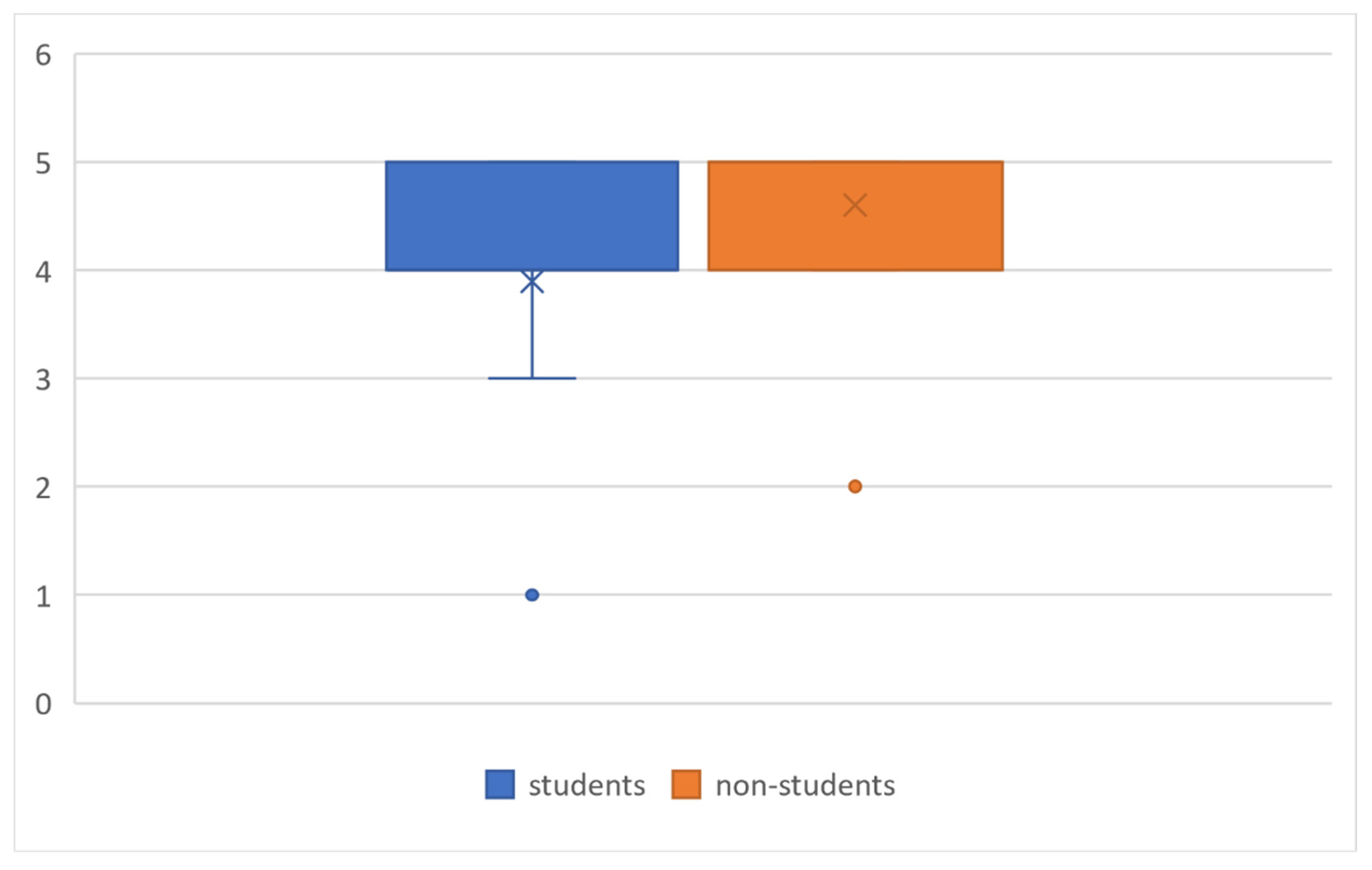
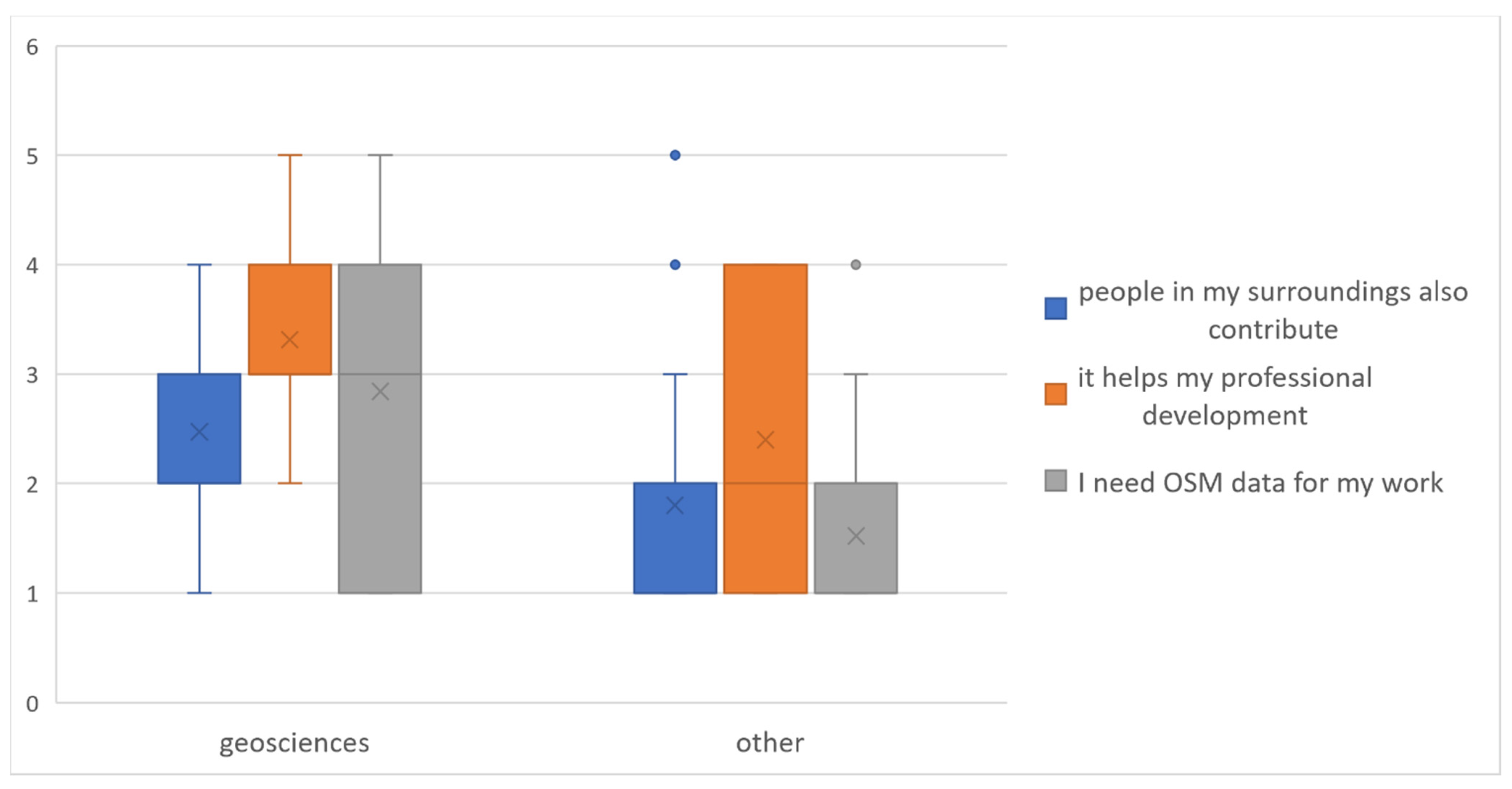
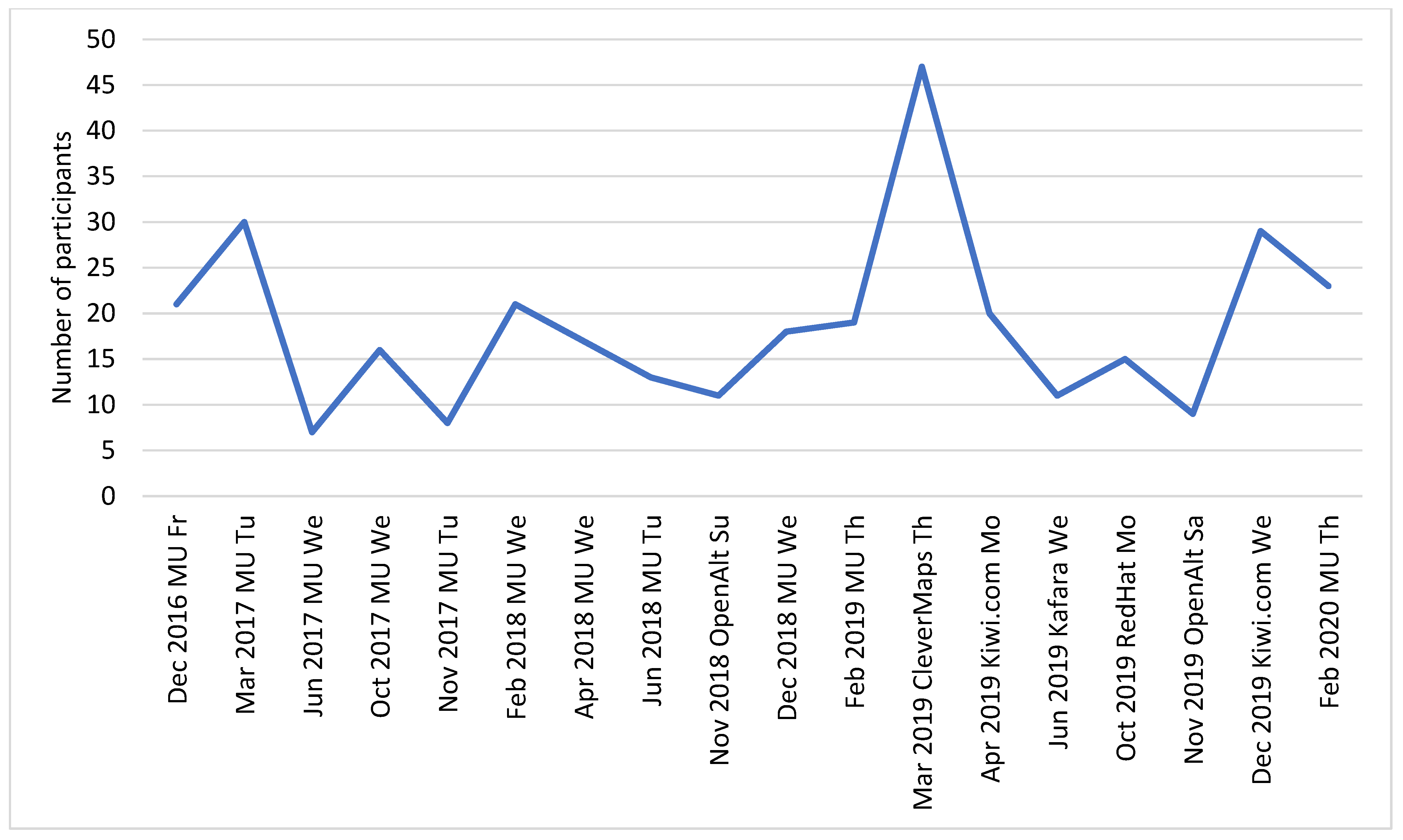
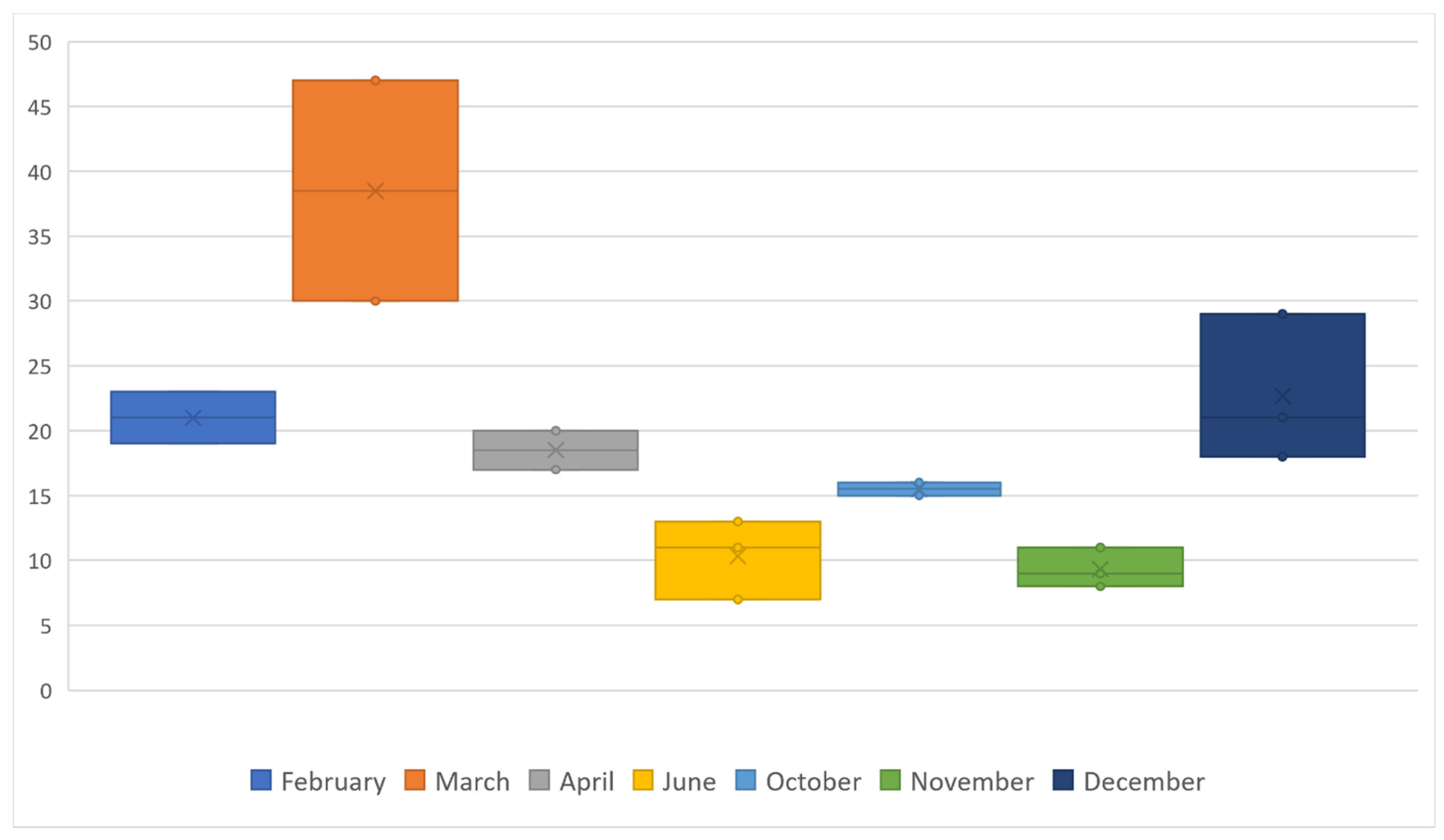
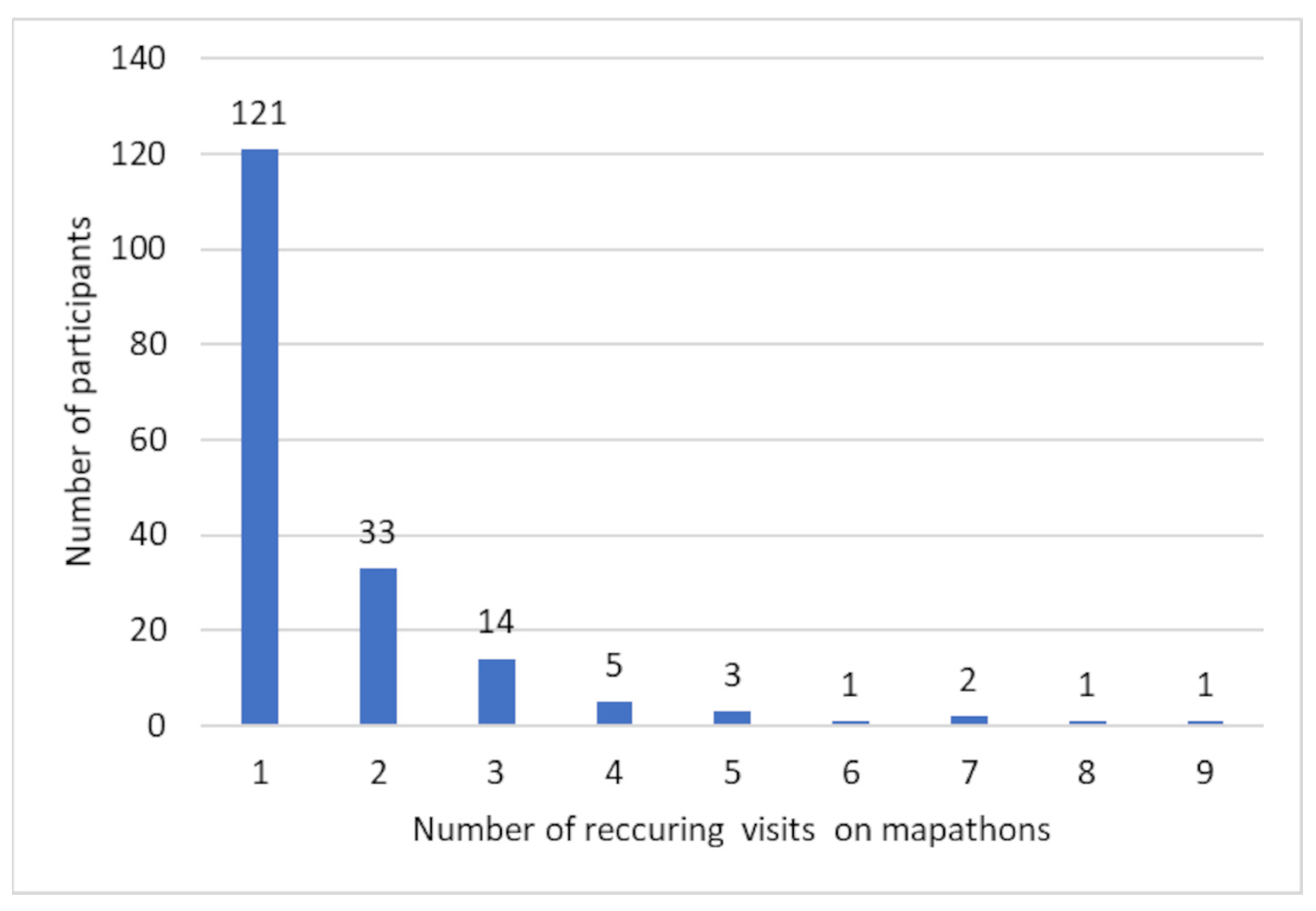
| Number of Participants | 44 |
|---|---|
| Experience (more experienced = more than 1000 edits) (%) | |
| less experienced | 38.6 |
| more experienced | 61.4 |
| Gender (%) | |
| Male | 68.2 |
| Female | 31.8 |
| Education (%) | |
| elementary school | 2.3 |
| high school | 25.0 |
| university—BSc. | 18.2 |
| university—MSc. and higher | 54.5 |
| Age (%) | |
| 25 and under | 29.6 |
| 26–35 | 50.0 |
| 36–45 | 13.6 |
| 46 and over | 6.8 |
| I Contribute Because… | Mean | Median |
|---|---|---|
| …I believe that my work yields significant results. | 4.5 | 5.0 |
| …helping other people is important to me. | 4.4 | 5.0 |
| …I like making maps. | 4.3 | 5.0 |
| …the community of volunteers around humanitarian mapping is important to me. | 4.2 | 4.0 |
| …I believe that digital maps should be accessible to everyone for free. | 4.1 | 4.0 |
| …I feel better and more satisfied with myself. | 4.1 | 4.0 |
| …it is a good means of self-realization. | 3.8 | 4.0 |
| …I like seeing immediate results. | 3.8 | 4.0 |
| …I want maps not to be created only for commercial purposes. | 3.6 | 4.0 |
| …I am a better human because of it. | 3.4 | 4.0 |
| …I feel that I am part of a bigger group because of it. | 3.2 | 3.0 |
| …it helps me to better understand geographical relationships. | 3.1 | 3.0 |
| …it helps me to better understand how the world works. | 3.1 | 3.0 |
| …it is a fine method of procrastination. | 3.0 | 3.0 |
| …it helps my professional development. | 2.8 | 3.0 |
| …it helps me to forget about personal problems. | 2.6 | 2.5 |
| …it is a good activity to include in my CV. | 2.3 | 2.0 |
| …people in my surroundings also contribute. | 2.1 | 2.0 |
| …I need OSM data for my work. | 2.1 | 2.0 |
| …it helps me to get the job I want. | 1.8 | 1.0 |
| …I get money for it. | 1.2 | 1.0 |
| Motivator | Status of Employment | Number of Participants | Median | Mean | Std Dev | Shapiro–Wilk Test | Mann–Whitney U Test | |
|---|---|---|---|---|---|---|---|---|
| p-Value | U | p-Value | ||||||
| I like making maps | student | 19 | 4.0 | 3.9 | 1.2 | 0.000 | 68.0 | 0.016 |
| non-student | 25 | 5.0 | 4.6 | 0.7 | 0.000 | |||
| Motivator | Status of Employment | Number of Participants | Median | Mean | Std Dev | Shapiro–Wilk Test | Mann–Whitney U Test | |
|---|---|---|---|---|---|---|---|---|
| p-Value | U | p-Value | ||||||
| people in my surroundings also contribute | geosciences | 19 | 2.0 | 2.5 | 1.1 | 0.022 | 144.5 | 0.028 |
| other | 25 | 1.0 | 1.8 | 1.2 | 0.000 | |||
| it helps my professional development | geosciences | 19 | 3.0 | 3.3 | 0.9 | 0.018 | 145.0 | 0.029 |
| other | 25 | 2.0 | 2.4 | 1.3 | 0.000 | |||
| I need OSM data for my work | geosciences | 19 | 3.0 | 2.8 | 1.5 | 0.031 | 113.0 | 0.003 |
| other | 25 | 1.0 | 1.5 | 0.8 | 0.000 | |||
| Month and Year | Weekday | Location | Attendees | Attendees that Used Borrowed Computer |
|---|---|---|---|---|
| December 2016 | Friday | Masaryk University | 21 | 3 |
| March 2017 | Tuesday | Masaryk University | 30 | 3 |
| June 2017 | Wednesday | Masaryk University | 7 | 1 |
| October 2017 | Wednesday | Masaryk University | 16 | 2 |
| November 2017 | Tuesday | Masaryk University | 8 | 1 |
| February 2018 | Wednesday | Masaryk University | 21 | 1 |
| April 2018 | Wednesday | Masaryk University | 17 | 0 |
| June 2018 | Tuesday | Masaryk University | 13 | 1 |
| November 2018 | Sunday | OpenAlt conference | 11 | not available |
| December 2018 | Wednesday | Masaryk University | 18 | 2 |
| February 2019 | Thursday | Masaryk University | 19 | 2 |
| March 2019 | Thursday | CleverMaps company | 47 | not available |
| April 2019 | Monday | Kiwi.com company | 20 | not available |
| June 2019 | Wednesday | Kafara community center | 11 | not available |
| October 2019 | Monday | Red Hat company | 15 | not available |
| November 2019 | Saturday | OpenAlt conference | 9 | not available |
| December 2019 | Wednesday | Kiwi.com company | 29 | not available |
| February 2020 | Thursday | Masaryk University | 23 | 5 |
| Mean | 18.6 | 1.9 | ||
| Median | 17.5 | 2.0 | ||
| Month | Number of Mapathons | Number of Participants | Mean | Median |
|---|---|---|---|---|
| February | 3 | 63 | 21.0 | 21.0 |
| March | 2 | 77 | 38.5 | 38.5 |
| April | 2 | 37 | 18.5 | 18.5 |
| June | 3 | 31 | 10.3 | 11.0 |
| October | 2 | 31 | 15.5 | 15.5 |
| November | 3 | 28 | 9.3 | 9.0 |
| December | 3 | 68 | 22.7 | 21.0 |
| Total | 18 | 335 | 18.6 | 17.5 |
Publisher’s Note: MDPI stays neutral with regard to jurisdictional claims in published maps and institutional affiliations. |
© 2021 by the authors. Licensee MDPI, Basel, Switzerland. This article is an open access article distributed under the terms and conditions of the Creative Commons Attribution (CC BY) license (https://creativecommons.org/licenses/by/4.0/).
Share and Cite
Štampach, R.; Herman, L.; Trojan, J.; Tajovská, K.; Řezník, T. Humanitarian Mapping as a Contribution to Achieving Sustainable Development Goals: Research into the Motivation of Volunteers and the Ideal Setting of Mapathons. Sustainability 2021, 13, 13991. https://doi.org/10.3390/su132413991
Štampach R, Herman L, Trojan J, Tajovská K, Řezník T. Humanitarian Mapping as a Contribution to Achieving Sustainable Development Goals: Research into the Motivation of Volunteers and the Ideal Setting of Mapathons. Sustainability. 2021; 13(24):13991. https://doi.org/10.3390/su132413991
Chicago/Turabian StyleŠtampach, Radim, Lukáš Herman, Jakub Trojan, Kateřina Tajovská, and Tomáš Řezník. 2021. "Humanitarian Mapping as a Contribution to Achieving Sustainable Development Goals: Research into the Motivation of Volunteers and the Ideal Setting of Mapathons" Sustainability 13, no. 24: 13991. https://doi.org/10.3390/su132413991
APA StyleŠtampach, R., Herman, L., Trojan, J., Tajovská, K., & Řezník, T. (2021). Humanitarian Mapping as a Contribution to Achieving Sustainable Development Goals: Research into the Motivation of Volunteers and the Ideal Setting of Mapathons. Sustainability, 13(24), 13991. https://doi.org/10.3390/su132413991







